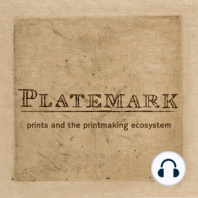90 min listen
s2e24 History of Prints Reproductive Prints (part four)
FromPlatemark
ratings:
Length:
64 minutes
Released:
Feb 21, 2023
Format:
Podcast episode
Description
Platemark s2e24 concludes hosts Ann Shafer and Tru Ludwig’s conversation on reproductive prints. The stars of this episode are Hendrick Goltzius and Peter Paul Rubens. It’s about the business of prints, artists getting their designs out there, and how these very transportable pieces of paper travelled throughout Europe and became catalogues of images for artists. Paper museums, if you will. Once again, for clarity, a reproductive print is one in which an artist creates a design (a drawing, painting, sculpture) and another artist creates a print after that original design. These can be sanctioned by the first artist or not or they can occur long after the first artist‘s death. It is customary to acknowledge all the artists in the strip of lettering at the bottom of the print (called the address). This way credit is given where due. Over time, reproductive prints became quite formulaic and staid—wait until we get to the early-nineteenth century. When photography was developed in the 1830s, it wasn’t long before there was little need for the reproductive print. But without them, there is virtually no history of prints in the West. Episode image: Christoffel Jegher (Flemish, 1596–1652/53) after Peter Paul Rubens (Flemish, 1577–1640). Hercules Triumphant over Discord, 1633–34. Woodcut. Sheet: 23 3/4 x 14 7/16 in. (60.33 x 36.67 cm.). Minneapolis Institute of Art, Minneapolis. Hans Sebald Beham (German, 1500–1550). The Large Village Fair, 1535. Woodcut from four blocks. Sheet: 36.7 × 114.9 cm. (14 1/2 × 45 1/4 in.). Metropolitan Museum of Art, New York. Johann Theodor de Bry (Netherlandish, 1561–1623) after Hans Sebald Beham (German, 1500–1550). Little Village Fair, 1588–1623. Engraving. Sheet: 109 x 281 mm. Rijksmuseum, Amsterdam. Jasper Isaac (French, active 1585–1654) after Hans Sebald Beham (German, 1500–1550). The Village Fair, 1620–1640. Engraving. Sheet: 154 x 403 mm. British Museum, London. Albrecht Dürer (German, 1471–1528). Agony in the Garden, 1515. Etching. Sheet: 9 3/16 × 6 9/16 in. (234 × 166 mm.). Metropolitan Museum of Art, New York. Parmigianino (Italian, 1503–1540). Entombment, c. 1527–30. Etching. Sheet: 13 1/16 x 9 7/16 in. (332 x 240 mm.). Metropolitan Museum of Art, New York. Federico Barocci (Italian, 1528–1612). The Stigmatization of Saint Francis, c. 1575. Etching, engraving, and drypoint. Sheet (trimmed to platemark): 228 x 145 mm. Achenbach Foundation for Graphic Arts, Fine Arts Museums of San Francisco. Federico Barocci (Italian, 1528–1612). The Annunciation, c. 1585. Etching and engraving. Sheet (trimmed within platemark): 17 3/8 × 12 5/16 in. (441 × 312 mm.). Metropolitan Museum of Art, New York. Pieter van der Heyden (Netherlandish, c. 1525–1569), after Pieter Brueghel the Elder (Netherlandish, 1526/30–1569). Big Fish East Little Fish, 1557. Engraving. Sheet (trimmed to platemark): 9 x 11 5/8 in. (22.9 x 29.6 cm.). Metropolitan Museum of Art, New York. Martin Schongauer (German, c. 1435/50–1491). Saint Anthony Tormented by Demons, c. 1470–75. Engraving. Sheet: 30 x 21.8 cm (11 13/16 x 8 9/16 in). Metropolitan Museum of Art, New York. Hieronymus Bosch (Netherlandish, 1450–1516). The Garden of Earthly Delights, 1490–1500. Oil on wood (triptych). Overall: 328.2 x 185.8 cm. Museo del Prado, Madrid. Philips Galle (Netherlandish, 1537–1612), after Pieter Brueghel the Elder (Netherlandish, 1526/30–1569). Justice, from the series The Seven Virtues, 1559–60. Engraving. Sheet: 10 1/4 x 13 3/16 in. (26 x 33.5 cm); plate: 8 7/8 x 11 7/16 in. (22.5 x 29 cm). Metropolitan Museum of Art, New York. Pieter van der Heyden (Netherlandish, c. 1525–1569), after Pieter Brueghel the Elder (Netherlandish, 1526/30–1569). Lust, from the series The Seven Deadly Sins, 1558. Engraving. Sheet (trimmed to platemark): 8 7/8 x 11 11/16 in. (22.6 x 29.7 cm.). National Gallery of Art, Washington, D.C. Titian (Venetian, 1488/1490–1576). The Submersion of Pharaoh’s Army in the Red Sea, 1514–15, printed 1549. Twelve woodcut
Released:
Feb 21, 2023
Format:
Podcast episode
Titles in the series (100)
s2e10 History of Prints The Italians (MarcAntonio Raimondi): MarcAntonio Raimondi, Veneziano, and Diana Scultori by Platemark
